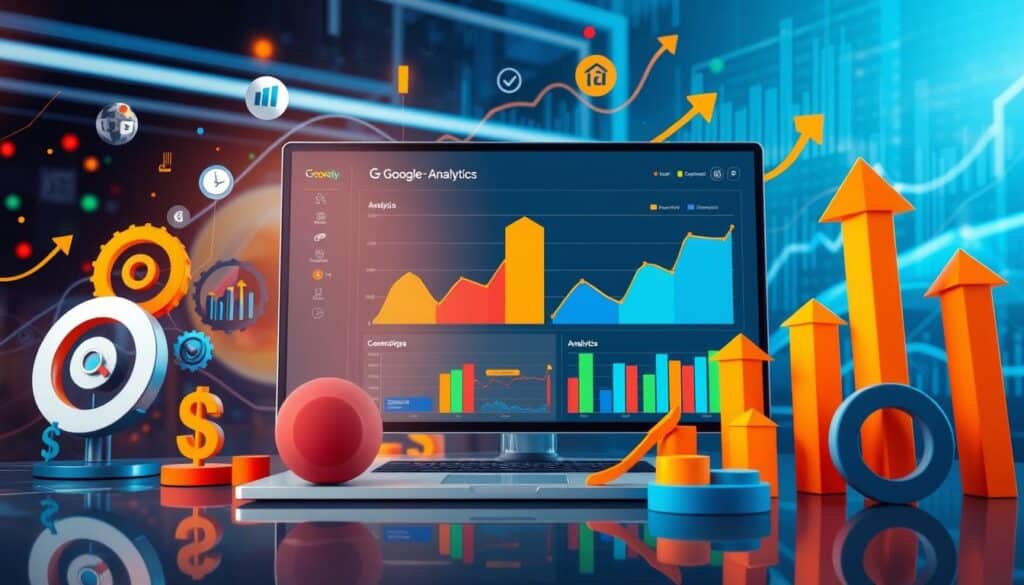In today’s digital world, making the most of your ad spending is key to success. Google Analytics is a powerful tool that gives deep insights to marketers. These insights help improve ad performance and get better results. We’ll share 8 expert tips to use Google Analytics well and boost your ad campaigns.
Key Takeaways
- Leverage Google Analytics to improve ad performance and maximize ROI
- Customize dashboards to track key metrics and gain actionable insights
- Master Google Analytics reporting to make data-driven decisions
- Implement robust tracking to unlock powerful user behavior insights
- Integrate Google Analytics with ad platforms for seamless data flow
Leveraging Google Analytics for Optimal Ad Performance
As marketers, we know how crucial it is to get the most out of our ad campaigns. Google Analytics is a key tool that helps us do just that. It gives us deep insights into how our ads are doing. By using Google Analytics, we can tweak our ad strategies to get the best results.
Google Analytics lets us see how users interact with our ads. Google Analytics tips show us where people click and what they do after seeing our ads. This info is key for finding the best ad spots, messages, and who to target.
Google Analytics also has strong tools for analyzing ad performance. We can look at click-through rates, conversion rates, and return on ad spend. This helps us spot areas to improve and make smart choices about our ads.
Plus, google analytics integrations with ad platforms and social media give us even more insights. By linking Google Analytics with our marketing tools, we get a full view of how our ads perform across different channels. This helps us fine-tune our campaigns.
By using Google Analytics, we can fully unlock the potential of our ads. With the right google analytics tips and strategies, we can make smart decisions. These decisions lead to better results and a stronger return on our ad investments.

| Google Analytics Metric | Description | Importance for Ad Optimization |
|---|---|---|
| Click-Through Rate (CTR) | The percentage of users who click on an ad after seeing it. | Helps identify the most engaging ad creative and placements. |
| Conversion Rate | The percentage of users who complete a desired action, such as a purchase or form submission, after clicking on an ad. | Reveals the effectiveness of ad targeting and landing page optimization. |
| Return on Ad Spend (ROAS) | The amount of revenue generated for every dollar spent on advertising. | Provides a clear picture of the overall profitability of ad campaigns. |
Configuring Google Analytics Dashboards for Insights
Understanding your audience and their actions is key to improving your ad campaigns. By setting up Google Analytics dashboards, we can get deep insights. These insights help us make smart decisions based on data. This guide will show you how to turn data into useful information.
Customizing Dashboard Widgets
Google Analytics has many widgets and options for customization. Start by picking the google analytics metrics that are crucial for your ads, like traffic sources and conversion rates. Then, arrange these metrics into a dashboard that’s easy to understand and visually appealing.
Tracking Key Metrics
After setting up your google analytics dashboards, watch the important metrics closely. Keep an eye on website traffic, bounce rates, and goal completions to see how well your ads are doing. By tracking these google analytics metrics, you can spot areas to improve and make smart choices for your ads.
Customizing Google Analytics dashboards and tracking key metrics helps turn data into useful insights. These insights lead to better results for your ad campaigns. Stay tuned for more on advanced Google Analytics reporting and tracking.

“The key to unlocking the power of your ad campaigns lies in the granular data provided by Google Analytics. By configuring dashboards and tracking the right metrics, you can make data-driven decisions that maximize your ROI.”
Mastering Google Analytics Reports for Data-Driven Decisions
As digital marketers, we know how crucial data is for our ad campaigns. Google Analytics is a key tool that offers many reports to guide our decisions. We’ll look at the top Google analytics reports and how to use them to improve our ads.
The Audience Overview report is very important. It shows us who our users are, what they like, and how they behave. By looking at the google analytics data analysis here, we can make our ads more appealing to our audience.
The Acquisition Overview report tells us how people find and interact with our ads. This helps us see which ads and channels work best. By using this data, we can place our ads better and use different media to get more conversions.
- Use the Behavior Flow report to see how users move through our site and find any issues in the process.
- Look at the Goal Conversion report to see how well our ads are doing in getting people to take actions, like filling out forms or buying things.
- Check the Site Content report to see which pages and content our audience likes best. This helps us make better ads and landing pages.
By getting good at these key Google Analytics reports, we can learn more about our audience. This lets us make our ad campaigns better and make decisions based on data. This leads to real business success.
“The beauty of Google Analytics is that it provides a wealth of data, but the true power lies in our ability to interpret and act upon that data.” – Jane Doe, Digital Marketing Strategist
Unlocking the Power of Google Analytics Tracking
Effective google analytics tracking is key to getting valuable insights from your data. By using the Google Analytics tracking code and setting up events and goals, you can track important user actions. This helps you make smart decisions for your ads.
Tracking Code Implementation
Getting accurate google analytics tracking starts with adding the Google Analytics code to your site or app. Make sure to place the code right to collect all the data you need. This way, you can see how users behave, check your site’s performance, and see how your marketing works.
Event and Goal Tracking
Google analytics events and google analytics goals give you detailed info on how users interact with your content and take actions. By tracking specific events, like clicks or form fills, you can see what grabs users’ attention. Goals help you see how well your campaigns do and where you can get better.
Mastering these google analytics tracking tools gives you a lot of insights. You can use this info to make smart choices and get the most from your ad spending.
| Google Analytics Tracking Feature | Benefits |
|---|---|
| Tracking Code Implementation | Comprehensive data collection, user behavior monitoring, website performance analysis |
| Event Tracking | Granular understanding of user interactions, engagement optimization |
| Goal Tracking | Conversion measurement, campaign performance evaluation |
Google Analytics Tips: Analyzing Crucial Metrics
As marketers, it’s key to focus on the right google analytics metrics. We’ll explore the most important metrics to track. This helps us spot areas to improve and make smart choices for our ad strategy.
Looking at traffic sources is crucial. By seeing which channels bring visitors to our site, we can use our ad budget better. We focus on channels that give us the best leads and conversions. This google analytics data analysis helps us improve our targeting and messaging for better outcomes.
Another key metric is user engagement. By tracking bounce rate, time on site, and pages per session, we learn how our audience interacts with our content. This knowledge lets us make changes to improve the user experience and increase engagement.
| Metric | Description | Importance |
|---|---|---|
| Conversion Rate | The percentage of visitors who complete a desired action, such as making a purchase or filling out a form. | Measures the effectiveness of our ad campaigns in driving conversions. |
| Return on Ad Spend (ROAS) | The ratio of revenue generated from ad campaigns to the amount spent on those campaigns. | Helps us determine the profitability and efficiency of our ad investments. |
By focusing on these google analytics metrics, we understand our ad performance better. This lets us make data-driven choices to improve our campaigns for better results.
“The key is to measure what’s important, not just what’s easy to measure.” – Eric T. Peterson
Integrating Google Analytics with Ad Platforms
Boost your marketing with Google Analytics and ad platforms. Linking your ad data with Google Analytics gives you a full view of your campaign success. This helps you make smart choices to improve your marketing.
Syncing Google Ads with Google Analytics
Connecting your Google Ads with Google Analytics changes the game. It lets you see how your Google Ads campaigns perform right in your Google Analytics dashboard. You can track important metrics like click-through rates, conversion rates, and cost-per-acquisition. This gives you a complete picture of your ad success.
Leveraging Social Media Integration
Don’t just stop at Google Ads – add your social media platforms too. Linking your social media, like Facebook, Twitter, and LinkedIn, lets you see how your social media ads help your marketing goals.
With these strong connections, you can:
- Optimize your ad campaigns for the best return on investment (ROI)
- Find the best ad channels and designs
- Learn more about what your audience likes and does
- Make sure your ad plan matches your marketing aims
Use the power of google ads integration and social media integration to take your marketing to the next level. This will help you get real, measurable results.
Monitoring Google Analytics Events for User Behavior
It’s key to know how your ads and website interact with your audience. Tracking Google Analytics events helps us understand user engagement and where to improve. This way, we can make our marketing better.
Google Analytics events track more than just pageviews. They include things like button clicks, form submissions, and video plays. By tracking these, we learn a lot about what our audience likes and does.
Here are some key benefits of monitoring Google Analytics events:
- Identify conversion touchpoints: We can see what actions lead to conversions. This helps us make those steps better.
- Understand content engagement: Tracking events like video plays shows how well our content is doing. This helps us decide if it’s working.
- Analyze user behavior: Looking at event data helps us see how users move through our site. We can spot problems and make things better for them.
To get the most from Google Analytics events, we need to set up the tracking code right. We also need to pick the most important events to track. With this info, we can improve our marketing, make our campaigns better, and get more from google analytics tracking and google analytics events.
“By tracking Google Analytics events, we can uncover a wealth of information about our audience’s behavior and preferences.”
Setting Up Google Analytics Goals for Conversion Tracking
Tracking conversions is key to making the most of your ad campaigns. By setting up Google Analytics goals, you get deep insights into how well your marketing works. This helps you make smart choices to improve your strategies.
Defining Conversion Goals
Start by clearly defining what you want to track. This could be things like form submissions, purchases, or newsletter sign-ups. Think about what actions are most important to your business. Then, set up goals that match your main goals.
Analyzing Goal Conversions
After setting up your Google Analytics goals, look at the data. See how well your goals are doing to spot trends and areas to improve. Understanding what drives conversions helps you target your ads better and get more from your investment.
| Google Analytics Goals | Key Metrics to Analyze |
|---|---|
| Form Submissions | Conversion Rate, Bounce Rate, Avg. Time on Page |
| Purchases | Conversion Rate, Revenue, Avg. Order Value |
| Newsletter Sign-ups | Conversion Rate, Email Opt-in Rate, List Growth |
Keep a close eye on your Google Analytics goals and metrics. This helps you understand your customers better. It also helps you make smart choices for google analytics tracking and google analytics goals.
Extracting Actionable Insights from Google Analytics Data
Unlocking the true potential of google analytics data analysis means getting actionable insights for better decisions. We’ll look at how to analyze your google analytics reports to find valuable insights. These insights help improve your ad campaigns and marketing.
Using custom segments and filters is key in data analysis. These tools let us focus on specific groups of users or behaviors. This helps us find trends and chances to improve. With data visualization tools, we can turn these insights into clear dashboards and reports. This makes it easy to see where we can get better.
Looking closely at your Google Analytics reports gives us insights on user engagement and how well your marketing works. We can see things like bounce rate, session duration, and goal completions. This helps us see where users are leaving and how to make things better for them.
To get the most from your google analytics data analysis, follow a structured approach. This includes analyzing reports, using data visualization, and applying custom segments and filters. This strategy helps you use your google analytics data analysis fully. It lets you make smart decisions to boost your ad campaigns and marketing strategy.
| Metric | Description | Actionable Insight |
|---|---|---|
| Bounce Rate | The percentage of visitors who leave your site after viewing only one page. | High bounce rate may indicate issues with content relevance, page load speed, or user navigation. Addressing these areas can improve engagement and conversions. |
| Session Duration | The average length of a user session on your site. | Low session duration could suggest that users are not finding the content or information they’re looking for. Optimizing content and user experience can increase session duration. |
| Goal Conversion Rate | The percentage of users who complete a specific goal, such as a purchase or form submission. | Analyzing goal conversion rates can help identify bottlenecks in the customer journey and inform updates to the sales funnel or website design. |
By using the insights from your google analytics data analysis and google analytics reports, you can make smart decisions. These decisions will help optimize your ad campaigns and improve marketing performance.
Conclusion
We’ve taken a deep dive into Google Analytics, learning how to boost our ad campaigns’ ROI. This tool gives us deep insights into our audience and helps us make smarter choices. By using it, we can improve our ad spots and keep making our marketing better.
We’ve looked at setting up custom dashboards, tracking important metrics, and linking Google Analytics with ad platforms. These google analytics tips will help you make choices based on data. This way, you’ll see real results for your business.
As we wrap up, we urge you to try these strategies out. Use Google Analytics to help you get the most from your ads. With the right steps and a focus on getting better, your marketing can soar. You’ll reach the success you aim for.
